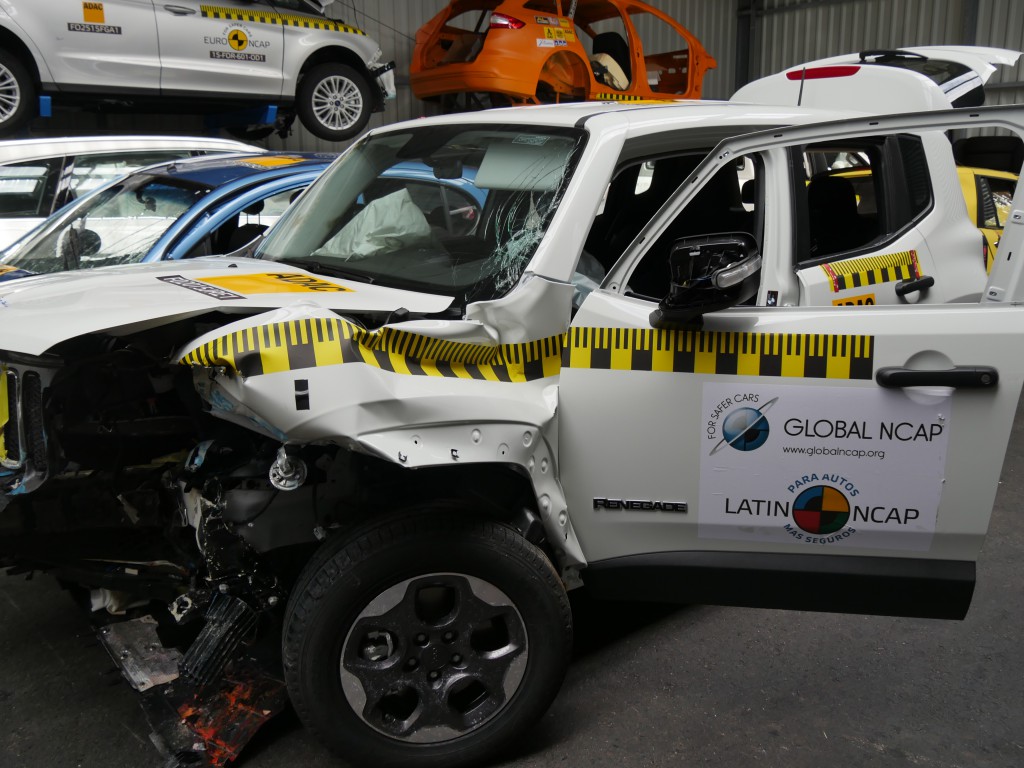My Visit to a Vehicle Testing Facility

SUV tested by Latin New Car Assessment Programme at ADAC testing facility in Landsberg, Germany. Technicians apply yellow tape to the outer frame, then measure how far back it “crumples” due to the collision, which shows the strength of the body shell
By Becky Bavinger, Bloomberg Philanthropies Public Health team
Looking at cars like the one above at a vehicle testing facility I recently visited in Germany, I was reminded of my first car. Driving to high school when I was 17, an eighteen-wheeler truck crossed the median and hit my Toyota Rav-4 head on. The impact caused my airbag to explode, seat-belt to engage, and engine to crumple inwards – leaving me terribly shocked and in pain, but very much alive.
Some bystanders helped me out of the passenger window, and luckily I emerged with nothing more than bad whiplash and some glass in my arm. But unluckily for much of the world’s population, they don’t live in a country with strong vehicle standards that require car manufacturers to install airbags, seat-belts, and sturdy metal frames – all of which can reduce the risk of serious injury and fatality in a crash. In fact, the combination of a seat-belt and airbag reduces the chance of dying in a crash by over 60 percent. But many vehicles in low- and middle-income countries don’t have these basic safety features. These cars are essentially death traps that provide little to no protection for occupants, like this one:
To improve vehicle safety worldwide, Bloomberg Philanthropies is partnering with the Global New Car Assessment Programme (Global NCAP) to test vehicles sold in Latin America, Southeast Asia, and India. As part of the Bloomberg Initiative for Global Road Safety, Global NCAP tests and rates vehicles on a 0 to 5 star scale. Many of the cars they assess for these regions receive very poor ratings (3 stars and below). After testing, Global NCAP releases the results to the public and urges manufacturers to voluntarily improve their safety features, while at the same time advising governments on best practice vehicle regulations.
In the United States and other high-income countries, the market is influenced by strict safety regulations and educated consumers who use Consumer Reports, or similar publications, to review the safety features and vehicle rating before purchase. But in low- and middle-income countries, Global NCAP’s Secretary General David Ward says that both a regulatory push from government and a demand pull from consumers are needed to get vehicle manufacturers to make safety improvements to their models.
The world’s vehicle fleet reached one billion in 2010, and is projected to double by 2020. Out of the 1.24 million deaths each year due to road traffic crashes, half of the fatalities are vehicle occupants. Because 90 percent of all the road crash fatalities occur in low- and middle-income countries, Bloomberg Philanthropies is focusing its efforts to improve vehicle standards in countries with a high volume of poor quality cars. We want to see cars like the one above, which protects occupants during a crash, available on the market at a competitive price in Latin America, India, and Southeast Asia. Basic safety features, like airbags, shouldn’t be a luxury.
The vehicle safety community has come a long way since cadaver and volunteer testing. Today, crash test dummies simulate the dimensions, weight proportions, and articulation of the human body. They’re fitted with cables to measure the energy absorbed during a collision, allowing technicians to estimate the effects on a real human.
In many countries where we work, child safety seats are uncommon and not mandated by the government. Global NCAP uses the highest recommended child safety seats in vehicle crash tests, and provides ratings for how a 3-year-old and an 18-month-old would fare during a collision. Our other road safety partners help identify legislative opportunities to mandate the use of appropriate child safety seats, and advocate for the passage of those laws.
As 75 percent of the global population is expected to live in urban settings by 2050, pedestrian safety has become a high priority for many consumers and manufacturers. Testing facilities across Europe now include pedestrian safety tests by testing vehicle collision against a simulated lower leg (knee joint), upper leg (femur), and head. Some manufacturers have developed material to use in the hood of a vehicle that is “softer” and absorbs energy as it collides with a pedestrian, reducing the risk of serious injury or fatality upon collision. But the most effective safety measure for any vehicle simply requires drivers to slow down – urban areas should set speed limits at 30 mph or lower to reduce fatal crashes between vehicles and pedestrians.
The Decade of Action for Road Safety (2011-2020) outlines Pillar 3 – improving vehicle safety by harmonizing relevant global standards, accelerating the uptake of safety technologies, and ensuring that all newly produced vehicles are equipped with basic safety features. Vehicle safety plays a critical role in reducing fatalities and injuries caused by road traffic crashes. Vehicle safety isn’t the only way to reduce fatalities and injuries caused by road crashes, but it’s a key element and we are proud to support Global NCAP as it continues to press for improved safety standards.
Thanks to safer vehicles & roads, improved legislation, and stronger enforcement, the latest WHO Global Status Report on Road Safety 2015 (funded by Bloomberg Philanthropies) indicates that worldwide the total number of road traffic deaths has plateaued at 1.25 million per year. However, there is an opportunity to do more. Urgent action is still needed to achieve the ambitious target for road safety reflected in the newly adopted 2030 Agenda for Sustainable Development: halving the global number of deaths and injuries from road traffic crashes by 2020.